
Volunteers help Maritime Park come alive
SAN FRANCISCO— It is no wonder tourists flock to the picturesque San Francisco Maritime National Historical Park. Seated right along the edge of the San Francisco Bay, it is the perfect place to experience history along with the natural beauty the city has to offer.
Of course taking the tours, walking around the Hyde Street Pier and exploring the real 19th Century ships are wonderful ways to pass the time. However, what can you do if you want to really get an insider’s perspective of the place? The answer is simple—volunteer of course.
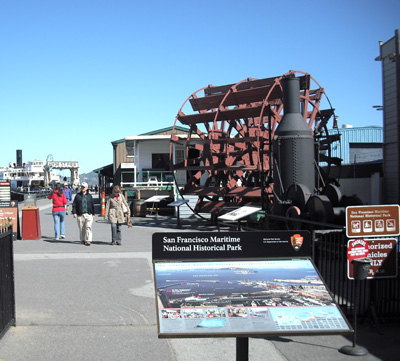 |
At left, a family walks past a water wheel at the Maritime National Historic Park (Photos by Gabrielle Officer). Below, the entrance to Hyde Street Pier. Boys play in a row boat. Behind them is the Balclutha, built in 1886. The park entrance sign. Volunteer Carlos Oliva works on his model of the Sea Witch. The souvenir shop promotes volunteering. |
“The volunteer program was set up to supplement the staff. We try to plug the holes when we have the lack of staff that we need,” said Terry Dorman, the park’s Volunteer Program manager.
The Volunteer Program at the park is unique. Volunteers are not just told to pick up the garbage people leave behind or to hand out brochures to passersby. The many activities that the volunteers have to choose from are extensive.
Volunteers can join the ship maintenance crew, restoring and maintaining the life of the ships in the pier. There is the rigging crew does all things a traditional sailors crew would do. You know the people that immediately start pulling on ropes and pushing sails when the captain gives an order—that’s them. Less strenuous is the docent crew, fully trained to give guided, historical tours of all the ships.
Another special program the maritime park has is a club called the Models Club. This club was established for anyone interested in building actual models of the ships built in the 1800s. The club is open to people of all skill levels, because the volunteers are taught by professionals how to construct the models.
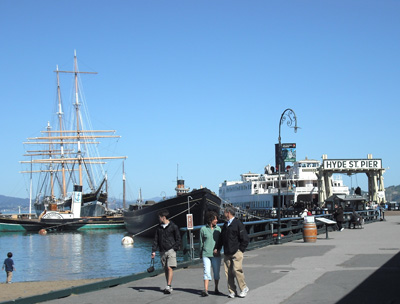 Every Saturday you’ll find volunteer modelers aboard the Eureka, a steam-powered ferryboat built in 1890. They work in a room no bigger than a large walk-in closet, filled with blueprints, power tools and wooden pieces of miniature ships. That is where Carlos Oliva, a first-year volunteer at the San Francisco Maritime National Historical Park, works on his model.
Every Saturday you’ll find volunteer modelers aboard the Eureka, a steam-powered ferryboat built in 1890. They work in a room no bigger than a large walk-in closet, filled with blueprints, power tools and wooden pieces of miniature ships. That is where Carlos Oliva, a first-year volunteer at the San Francisco Maritime National Historical Park, works on his model.
“What we do is construct ships that represent the history of the 1800s and the maritime history of San Francisco,” said Oliva. “This ship has been built by scratch. We have the plans and we create and handcraft all the parts.”
When asked how becoming a volunteer and joining the club has been a benefit he said it is centered on people and learning about the ships.
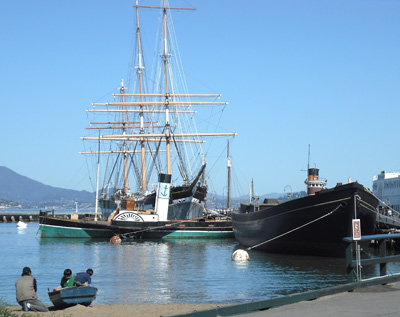 “The greatest resource for me to learn has been joining the club and to come meet different people that have a lot of experience building the ships. So that’s why I came here and I was interested to come. Sometimes [just] reading is very complicated, but when someone comes in and teaches you learn much better and you enjoy it much more.”
“The greatest resource for me to learn has been joining the club and to come meet different people that have a lot of experience building the ships. So that’s why I came here and I was interested to come. Sometimes [just] reading is very complicated, but when someone comes in and teaches you learn much better and you enjoy it much more.”
“We do everything cool here,” said Dorman.
There is a set of volunteers that are part of the Living History Players. Five years ago there we only about four or five participants. Today this group of about 30 to 35 volunteer actors gather around at the park on the second Saturday of every month to reenact the year 1901.
Dressed in full costume and fully committed to their characters, these actors tell stories, interact with visitors and do activities that were common for a person living in San Francisco during that time.
“If you ask them about an ATM or and iPod, you’re asking the wrong people because those things simply did not exist in 1901,” Dorman said with a chuckle.
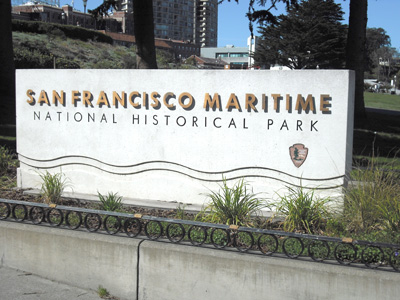 “They can tell you about anything during 1901 though,” he added.
“They can tell you about anything during 1901 though,” he added.
The training to become a Living History Player takes place in February. There volunteers, get history on life during the late 1800s and early 1900s, and instruction on how to immerse themselves in the life of someone living at that time.
The volunteer program has grown exponentially since its inception in 1984. Usually volunteers cannot be any younger than 15 years old. However, starting in 2010, the park will open its doors to many eager younger volunteers with its Youth Volunteer Program.
“We also have group volunteers or corporate volunteers, which is a very important part,” said Dorman. “One of our favorite volunteer teams is AAA of Northern California.”
Becoming a volunteer is relatively simple.
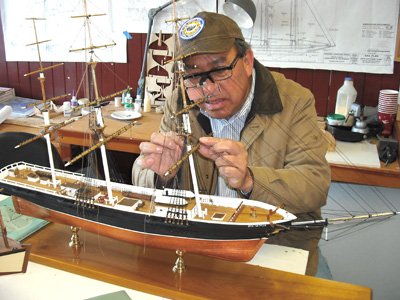 “All you have to do is contact this office,” said Dorman. There is an application to fill out, and an interview process to assure that the park is getting good representatives of the National Park Service.
“All you have to do is contact this office,” said Dorman. There is an application to fill out, and an interview process to assure that the park is getting good representatives of the National Park Service.
Volunteers are provided with everything they need to get their jobs done, including uniforms and any personal protective equipment.
The program also plans to expand its program roster. By next year they hope to have a garden club for a Victorian garden in the area called the Victoria Garden. There is also a beach clean up team and environmental science team being put together.
“We invite everyone that’s interested on coming down to help us,” exclaimed Dorman.
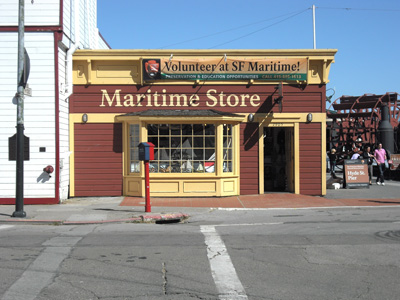 If You Volunteer…
If You Volunteer…
To submit an application you can:
1. Stop in the volunteer office located at the intersection of Hyde Street and Jefferson Street at the Hyde Street Pier.
2. E-mail the Volunteer Program Manager, Terry Dorman at terry_dorman@nps.gov.
Put the word VOLUNTEER in the subject box.
3. Call the volunteer office at 415-556-1613.
For more information visit the park’s officlal·Web site at http://www.nps.gov/safr/supportyourpark/volunteer.htm.

Comments are Closed